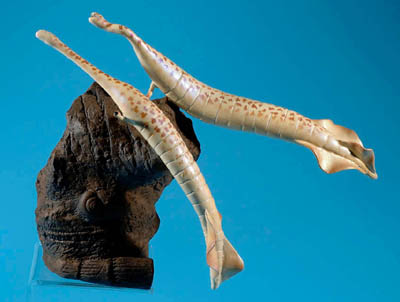Animals from Marine Environments

Illinois State Museum Exhibit
Near shore, where rivers mixed with the sea, the water was brackish. A variety of clams, snails, worms, shrimp, jellyfish, sea cucumbers, fish, and other animals thrived. One of the most unusual was the Tully monster (Tullimonstrum gregarium), a soft bodied creature with sensory organs, possibly eyes, mounted on stalks. It had a long flexible snout with a claw that was probably used to grab food. The Tully monster is Illinois' state fossil.
Further offshore, typical limestone-building faunas were present, such as sponges, corals, bryozoans, brachiopods, cephalopods, and crinoids.
Freshwater to brackish water Braidwood faunal community with fish (including spiral shark egg cases), arthropods, and the snake-like amphibian Aornerpeton
Near-shore estuarine habitat with typical Essex fauna, including a variety of mollusks, fish, arthropods, jellyfish, worms, and the Tully monster
Offshore estuarine habitat with typical bottom-dwelling Essex fauna, including worms, mollusks, arthropods, inarticulate brachiopods, jellyfish, and fish.
The Mazon Creek region of Illinois is world famous for fossils. Nodules that have eroded out of streambeds or been excavated in mining oerations contain well-preserved fossils of plants and animals from Pennsylvanian freshwater and marine environments.
Learn More at the Museum's Mazon
Creek Online Exhibit